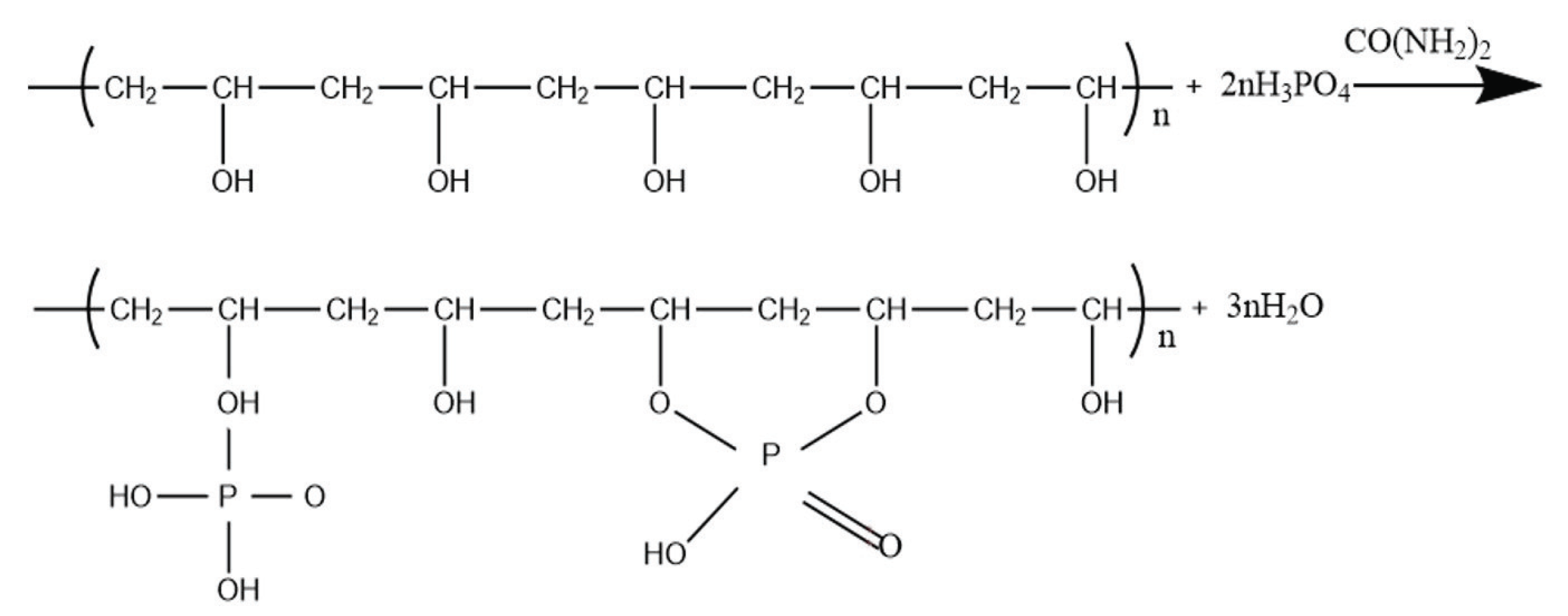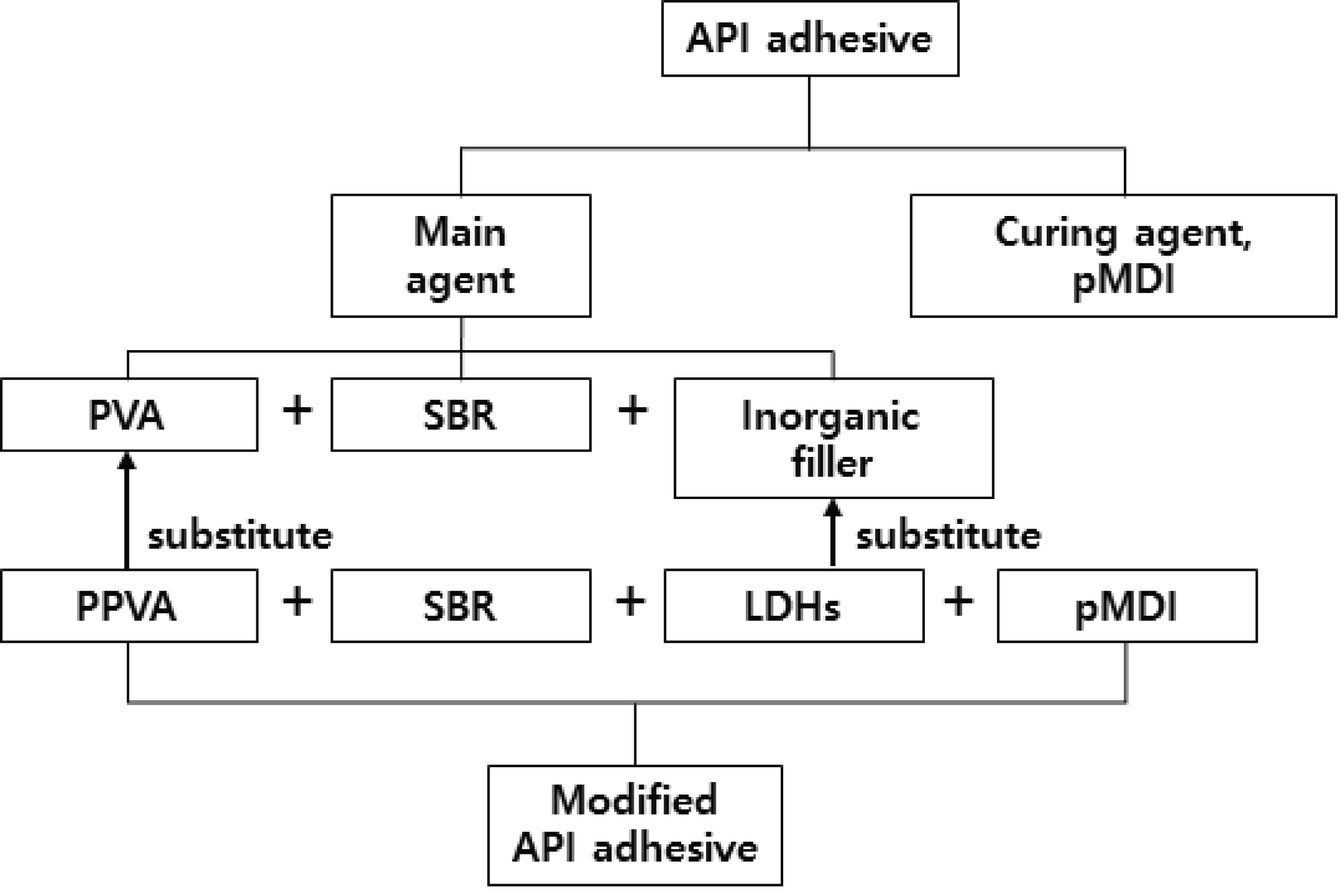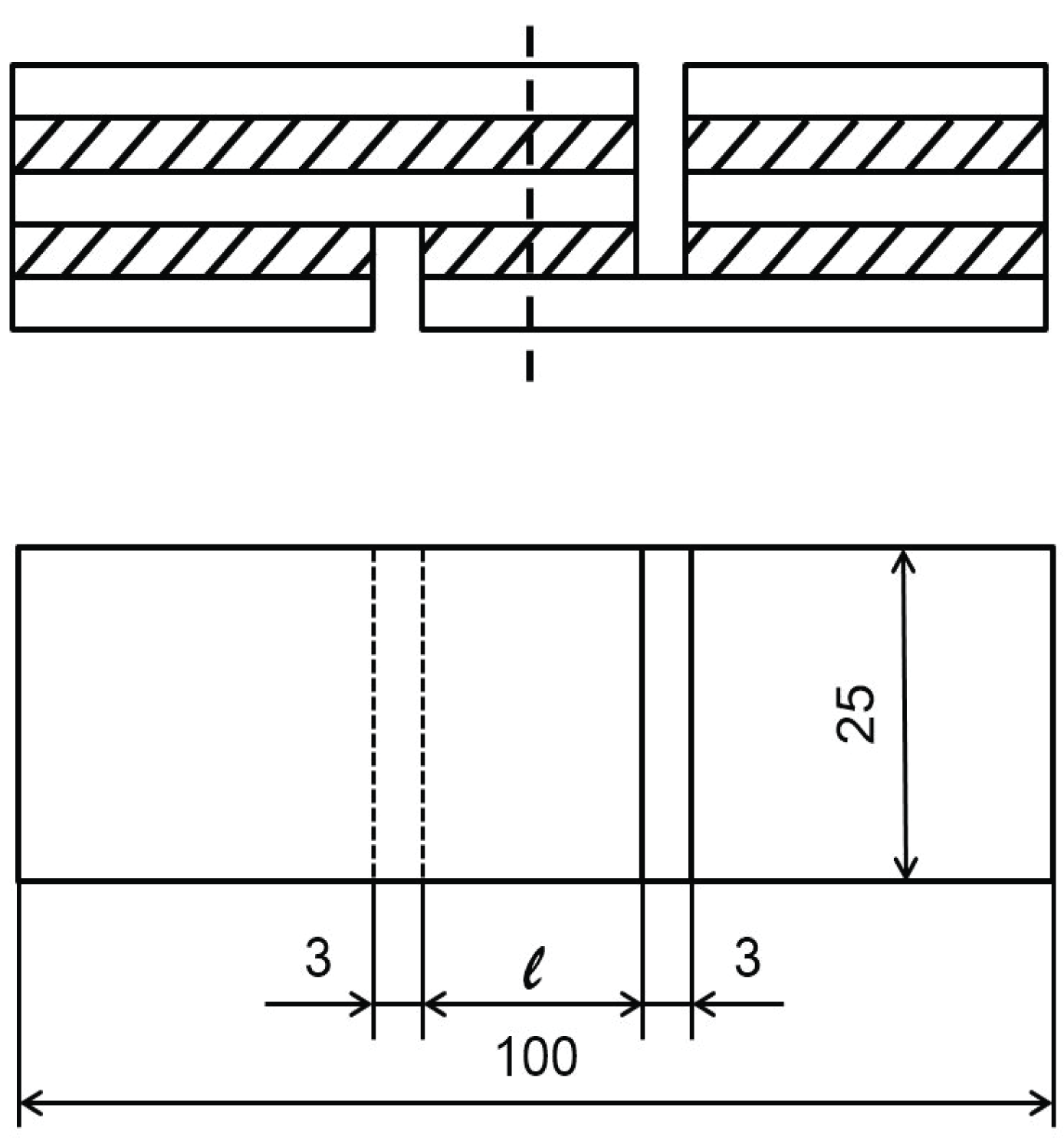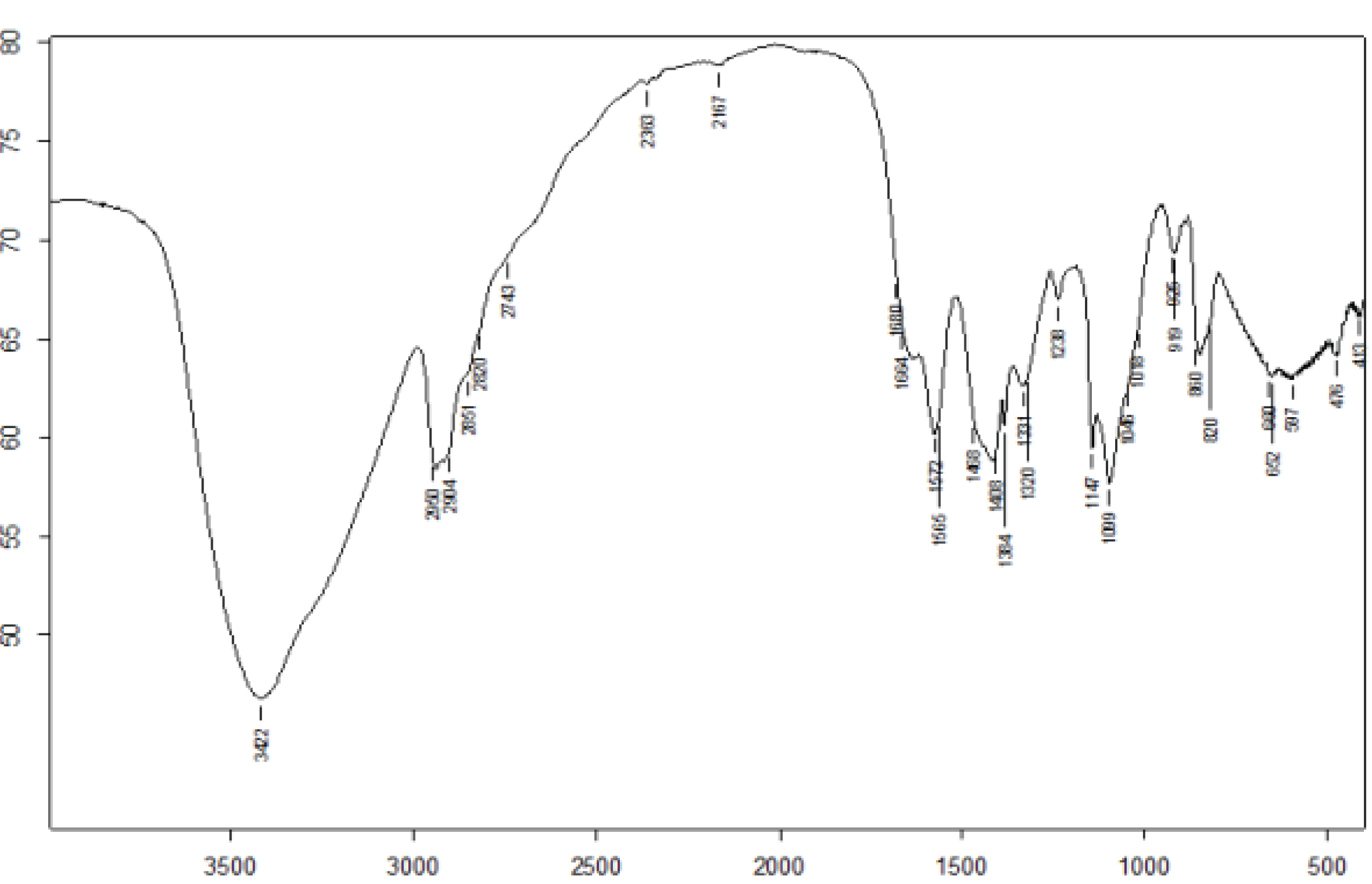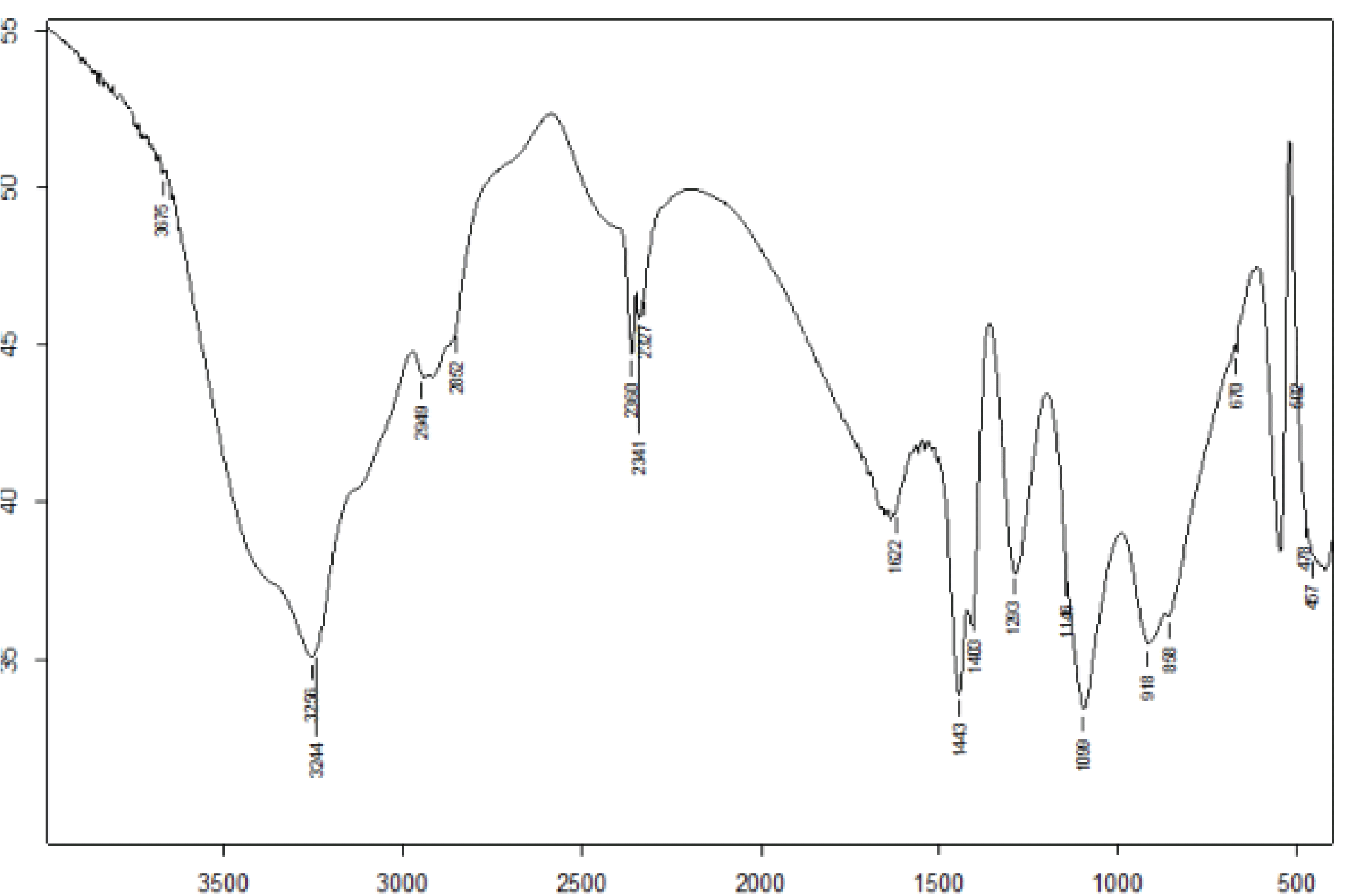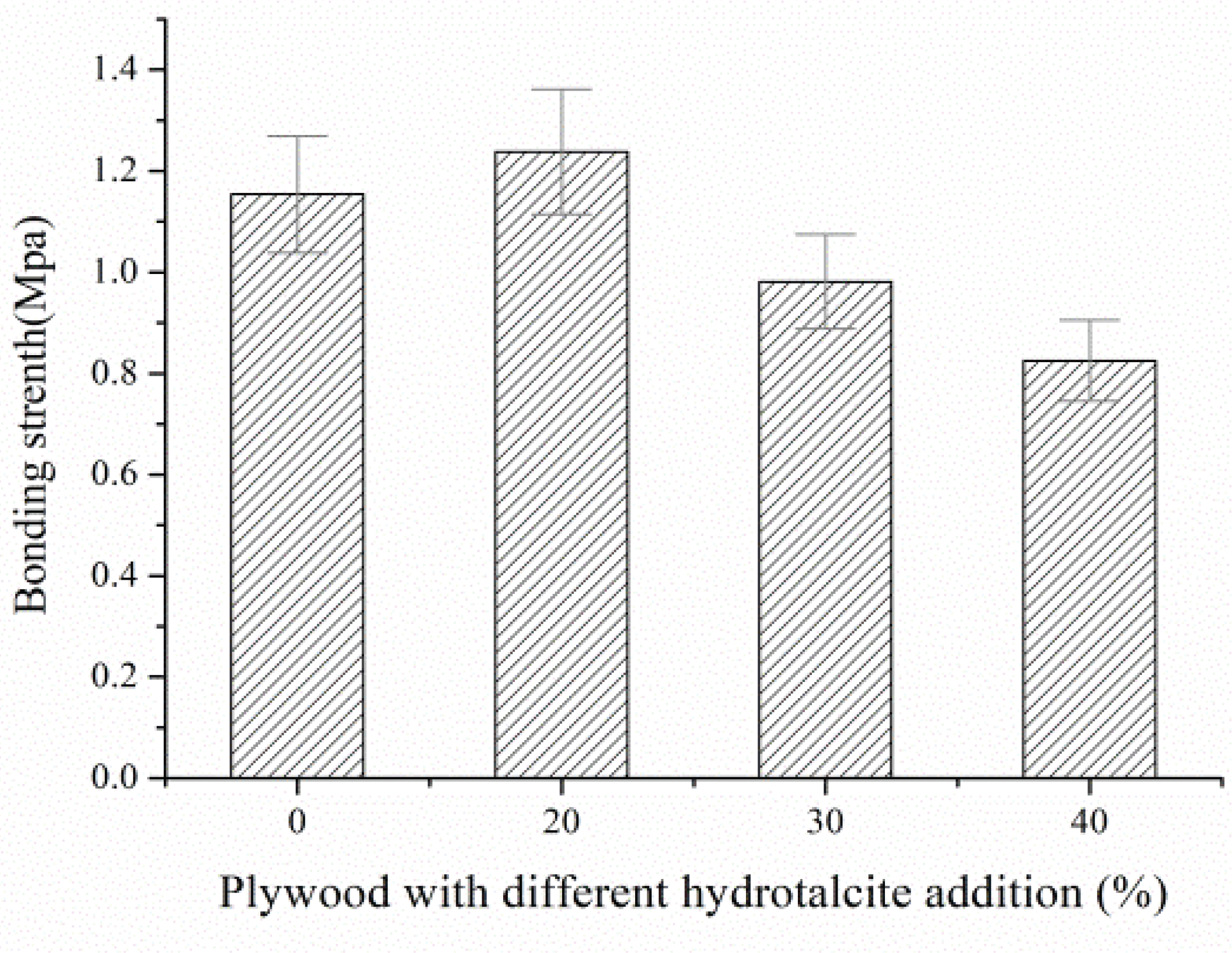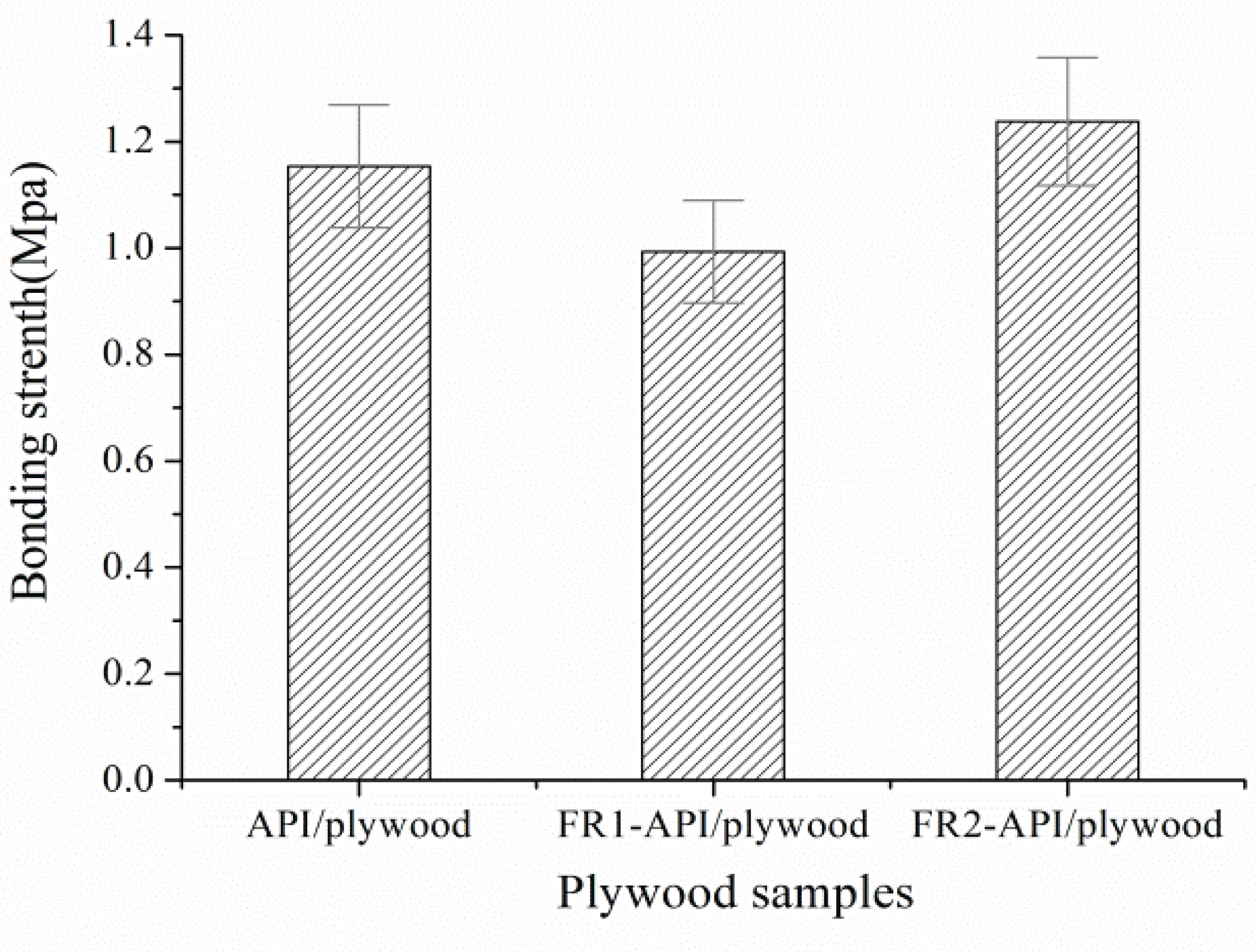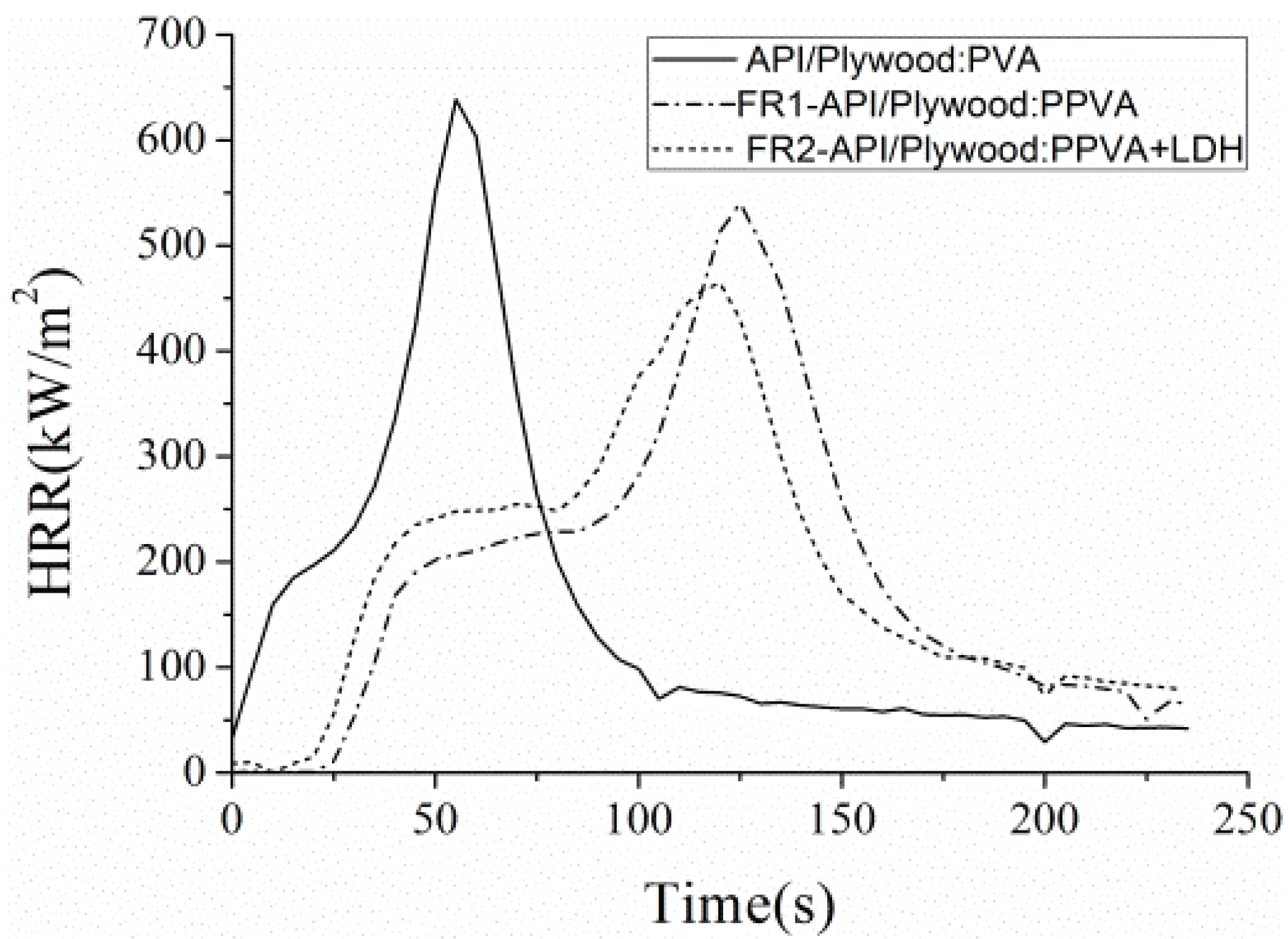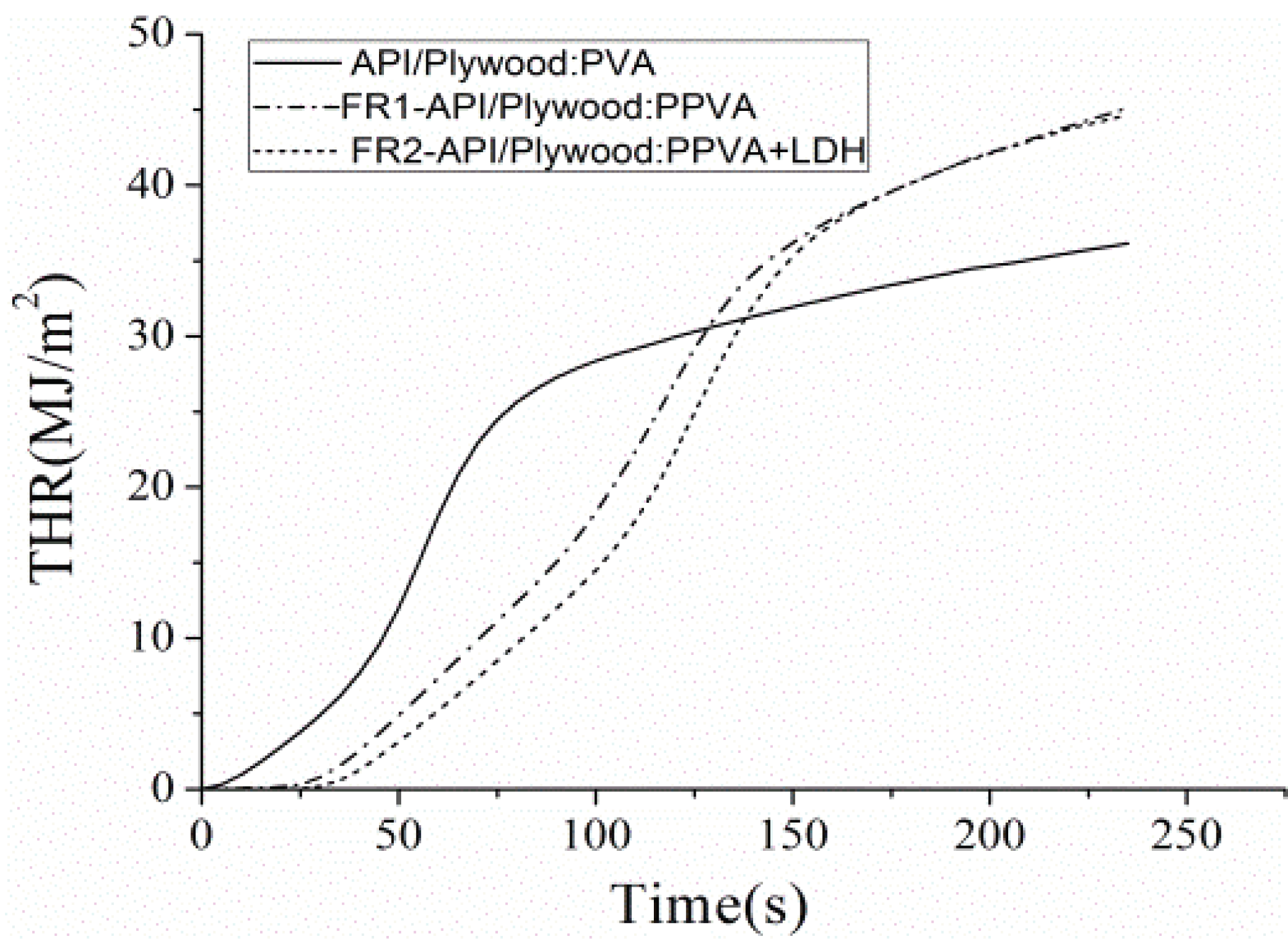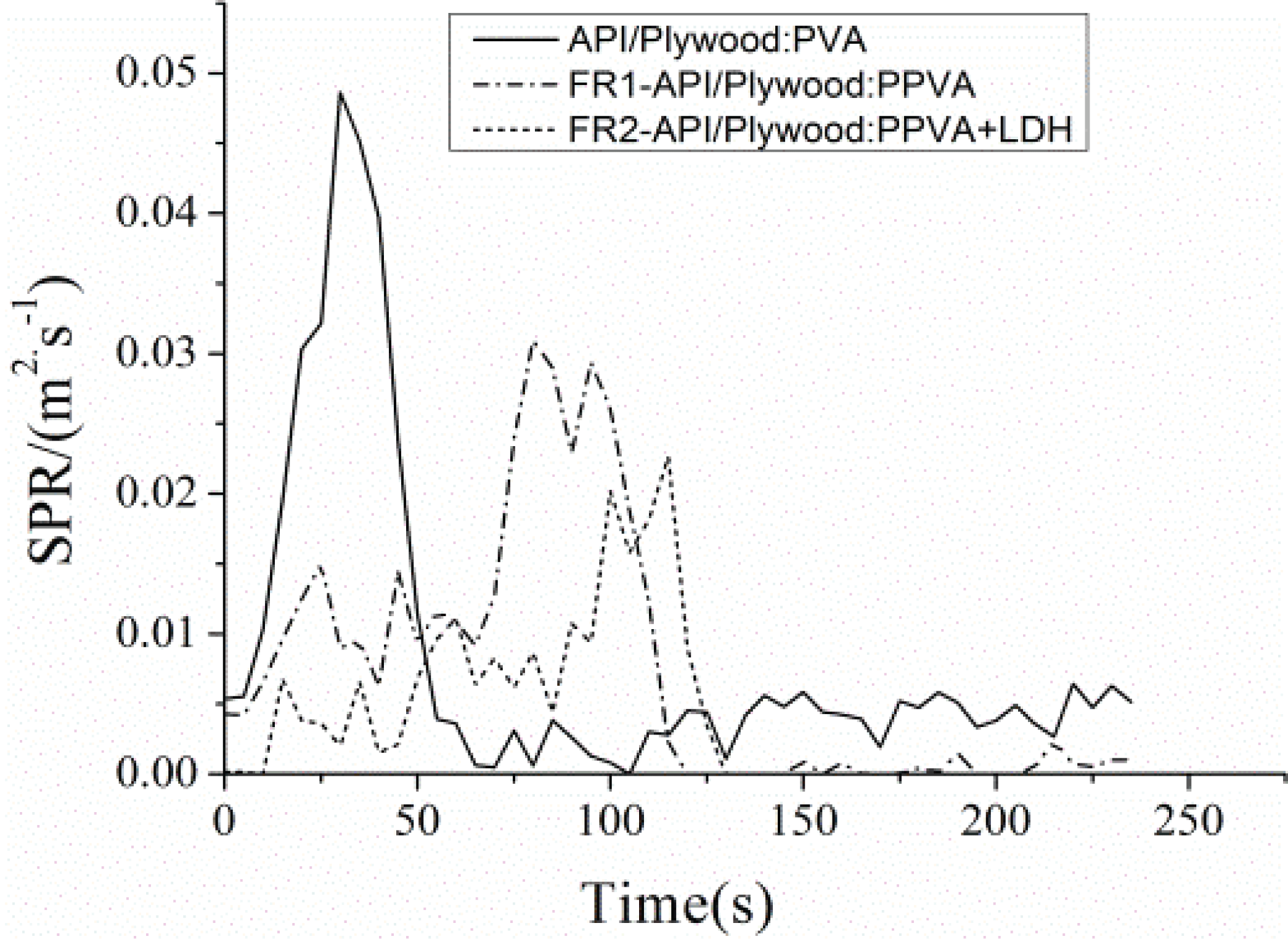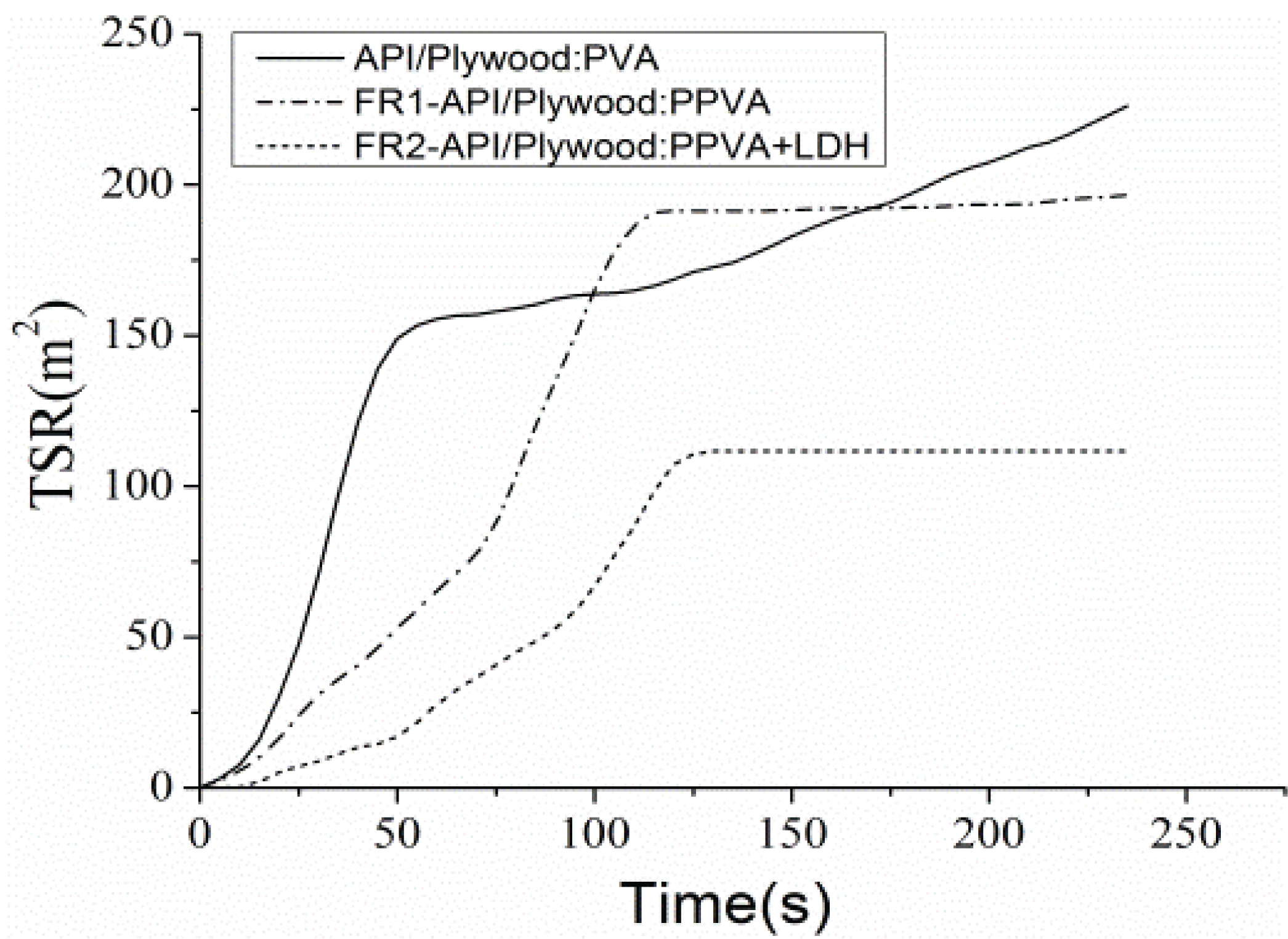1. INTRODUCTION
Plywood is widely used in furniture manufacture, residential and commercial interior finish and casework applications. Presently, urea formaldehyde resin (UF), phenol formaldehyde resin (PF) and melamine- urea formaldehyde resin (MUF) are widely used in plywood products (Park et al., 2020). However, these resins will release formaldehyde during plywood manufacturing and using. So there is much interest in developing and applying environmental friendly and bio-based adhesive in plywood products. Meanwhile, the main components of plywood are the same as that of wood, i.e., cellulose, hemicellulose and lignin (Fateh et al., 2014). So plywood is flammable and easy to cause fire hazard in house. Therefore, it is necessary to prepare flame retardant formaldehyde-free plywood in order to ensure the safety of people and residence.
Three methods are commonly employed to provide plywood with fire resistance: chemical impregnation of veneer (Ling et al., 2018), incorporation of flame retardants into the adhesive(Wang et al., 2018), and flame-retardant coatings (Wang and Zhao, 2018). Commonly, for the second method, the incorporation of flame retardants inevitably increases the viscosity and curing time, and decreases the bond strength of the adhesive (Yan et al., 2018). Therefore, it is crucial to choose appropriate flame retardant (Park et al., 2012, 2013).
Due to a pronounced mechanical performance and being environmental friendly, aqueous polymer isocyanate adhesive (API) has been widely applied in the production of formaldehyde-free plywood. The typical main component of API is aqueous poly(vinyl alcohol) (PVA) solution, vinyl acetate homopolymer and copolymer emulsion or carboxylated styrene–butadiene rubber latex (SBR). Polymeric diphenylmethane diisocyanate (pMDI) is the preferred crosslinker (Zhang et al., 2020).
Polyvinyl alcohol (PVA) as a main agent in API adhesive formula is a kind of water-soluble polymer with excellent hydrophilicity, good heat and chemical stability (Guo et al., 2019; Shen et al., 2019). To further improve the flame retardant of PVA, a phosphorylated polyvinyl alcohol (PPVA) was synthesized by esterification reaction of PVA and phosphoric acid in the aqueous solution, which entangle of polymer molecular chains and hydrogen bonding (intramolecular hydrogen bond and intermolecular hydrogen bond). It is reported that PPVA exhibits more effective stabilization in polymerization, higher water resistance and mechanical property than PVA (Fei et al., 2020; Kusakabe et al., 2017). However, most research was conducted on PVA polymer film or coating.
Layered double hydroxides (LDH) with Mg2+ and Al3+ cations and carbonate interlayer anions (MgAl- CO3) possesses the similar structure and composition as Mg(OH)2 and Al(OH)3 flame retardants. LDH is characterized by tunable chemical compositions and layered structures. Many investigations have demonstrated that LDH is excellent non-toxic and smokesuppressing environmental-friendly inorganic additives (Cai et al., 2020; Zhang et al., 2020). Their thermal decomposition follows an endothermic reaction to decrease the temperature of materials and releases water into the gas phase to dilute the flame (Hu et al., 2019). MgAl-CO3 is a very efficient halogen-free flame retardant additive that can reduce heat release rate (HRR) and suppress smoke (Xu et al., 2018). However, most studies use LDH as inorganic filer in polymer (Xu et al., 2020).
In addition, phosphorus-containing compounds as efficient halogen-free flame retardants have been widely used. Studies have showed that the physical properties and bonding performance of flame retarded wood based composite was lowered by 10%-40%. It hinders the application of flame retardant plywood products (Ye and Qu, 2008). Meanwhile, this kind flame retardant are often used alone or combined with Mg (OH)2 and Al(OH)3, which are able to increase the conversion of organic matter to charred layers during burning (Choi et al., 2018). However, few studies have studied the application of PPVA in modifying API adhesive even with the combination of Mg-Al LDH to prepare formaldehyde flame retardant plywood, which do not negatively affect bonding strength of plywood(Oh and Park, 2018).
In the present work, a functional group with flame retardant property -PO43- 13reacted into PVA was prepared and used as phosphorus containing flame retardant. Though phosphoric acid esterification reaction, the flame retardant element P is introduced into the molecular chain of PVA to achieve the effect of permanent flame retardant. The Phosphorylated polyvinyl alcohol (PPVA) was characterized by FT-IR to understand the structure. PPVA and inorganic filler double layer hydroxides (LDH) with Mg2+ and Al3+ were used to prepare flame retardant API adhesive in order increase flame retardant of the glued plywood. The bonding strength and flame retardant performance of such fire retardant API adhesive glued plywood were investigated and compared to those of the conventional API adhesive glued plywood. And the flame retardant mechanism was discussed.
2. MATERIALS and METHODS
The poplar veneer, the origin is northeast China, with the size of 1.2 mm × 300 mm × 300 mm, the moisture content is 8%~10%.
The polyvinyl alcohol (PVA), with a degree of saponification of 99.1% and a MW of 1 × 104 g/mol, was purchased from purchased from Tianjin Beichen fangzheng reagent factory. Styrene-butadiene rubber (SBR) latex was used as a softener, supplied by NIPPON A & L (Japan), with a solids content of 51.7% and a styrene/ butadiene mass ratio of 3/7. Polymethylene polyphenyl polyisocyanate, MR-200 (pMDI), supplied by Yantai Wanhua (China) had an NCO content of 30.5-32.0%. Phosphoric acid, Urea was purchased guangdong zhongpeng chemical co., LTD. ; Ethanol (95%), Tianjin Damao chemical reagent factory, Sodium hydroxide, Tianjin Yongda chemical reagent co., LTD. ; Hydrotalcite, Zhengzhou Guanda chemical products co. LTD.
Phosphorylated polyvinyl alcohol (PPVA) was prepared through the esterification reaction in water media, in which urea acted as a catalyst for dehydration and phosphoric acid acted as an esterification agent. And the synthetic route of PPVA was presented in Fig. 1. Phosphoric acid esterification of polyvinyl alcohol (PPVA) synthesis reaction: Phosphorylated PVA was prepared by the reaction of PVA(10 g), phosphoric acid (41.5 g) and urea (20 g) in deionized water. Polyvinyl alcohol (PVA) was placed in a 500 ml three-bottle flask. When the solution temperature reaches 50°C, urea was added as catalyst. Then it was heated to 95°C, allowing the PVA to dissolve completely, phosphoric acid (H3PO4) solution was slowly added in about 30 mins, and then reacted at 95°C for 3 hours. After the reaction, the solution was cooled to room temperature. Purified PPVA was obtained by precipitation in ethanol. The precipitate was cut into pieces and washed with anhydrous ethanol until the PH value stabilized between 5 and 6. And then dried in a vacuum at 40°C for 48hr. The extent of phosphorylation for PPVA was around 10%.
PVA and PPVA aqueous solution: 10g PVA or PPVA powder was added into a three neck flask with 90g deionized water and stirred at a constant temperature of about 50°C. After full swelling, they were heated to 95°C and dissolved for about 3 hours until PVA or PPVA dissolve completely.
API adhesive: 70 g PVA aqueous solution and 30 g SBR latex were mixed together in a plastic container (50 ml), and then the inorganic filler CaCO3 20 g was added and stirred together. Then 10 g pMDI was added into the PVA-SBR mixture, stirred for 2-35 min.
Modified API adhesives: PPVA was used as a substitute for PVA, PPVA:SBR=7:3. The addition of curing agent p-MDI accounted for 10wt.% of the main agent. The addition of inorganic filler Mg-Al layered double hydroxides (LDH) as substitute for CaCO3 was fixed at 20wt.%, 30wt.% and 40wt.% of the main agent of API adhesive. The formula of API adhesives was shown in Fig. 2.
Three-layer plywood was manufactured under the parameters of gluing spread content 320 g/m2 (double sides) of API adhesives, hot pressing temperature 110°C, hot pressing time 216 sec., unit pressure 1.1 MPa. The plywood prepared with different API adhesives was shown in Table 1.
| API/Plywood | API adhesive | PVA+SBR+P-MDI+ filler CaCO3 |
|---|---|---|
| FR1-API/Plywood | FR1-API adhesive | PPVA+SBR+P-MDI+ filler CaCO3 |
| FR2-API/Plywood | FR2-API adhesive | PPVA+SBR+P-MDI+ Mg-Al LDH |
In this study FT-IR were utilized to assess phosphorylated PVA. Fourier transform infrared spectroscopy of PVA and PPVA was performed on thin film samples with TENSOR II spectrometer (Bruker, Geman) (KBr beam splitter, resolution 4 cm-1, 32 scans, 400-4000 cm-1) in a dry air atmosphere.
The fire retardant performances of samples were assessed using the cone calorimeter according to GB/T 16172-2007/ISO 5660-1:2002 with three replicated experiments. The surface heated area of sample was 100 × 100 mm and exposed horizontally at the heat flux of 35 kW/m2. The heating time is 10min. The following parameters were determined: THR, HRR, SPR and Total smoke production.
The shear strength of the plywood samples was determined using a universal test machine (MWD-10B) in accordance with Chinese standard GB/T 9846-2015 for plywood type II. The specimens were submerged in deionized water at RT for 24 hr. or 63°C for 3 hr. for the wet shear strength test. Then, they were air-dried at RT for 10min. before testing. Each group was prepared 9 specimens from each three plywood replication. The specimen of tensile shear bonding strength test was shown in Fig. 3.
Test method: clamp both ends of the specimen in a straight line. The center of the specimen shall pass through the axis of the movable clamp of the universal mechanical testing machine. The distance between the clamping part and the notch of the specimen shall be within 5 mm. Then, the specimens were loaded until failure at a constant speed of 10 MPa/min. The maximum damage load was recorded. The tensile shear bonding strength (MPa) was calculated by the following equation:
where, σ: Tensile shear bonding strength (MPa)
Pmax : The maximum failure load (N)
b : The width of shear section (mm)
l : The length of shear section (mm)
3. RESULTS and DISCUSSION
Phosphorylated poly(vinyl alcohol) PPVA was prepared, as a substitute for PVA in API adhesive formula. Through the esterification reaction, the flame retardant element P was introduced in to the molecular chain of PVA. The FT-IR spectroscopy is an effective way to detect whether PPVA is successfully grafted. The test results of PVA and PPVA were shown in Fig. 4 and 5.
The stretching peak of P-O-C was located at 1055-950 cm-1. Esters C-O stretching vibration absorption peak was located at 1300-1100 cm-1. With the C-O connected to the different groups, the absorption peak position would change. Therefore, the absorption peak near the 1099 cm-1 is the coincidence of the absorption peak of the C-O stretching vibration and the P-O-C absorption peak. The absorption peak of P=O bond with moderate intensity appeared 1622 cm-1.So these results show that P=O bond had been successfully introduced and the synthesis scheme and conditions can successfully obtain the required.
Boding strength is a key parameter for adhesives. The bonding strength of all plywood glued by API adhesives was higher than 0.70 MPa. According to the Chinese standard GB/T 9846-2004, the bonding strength for Plywood II must be equal to or higher than 0.70 MPa.
The addition of inorganic flame retardant Mg-Al LDH was investigated. As shown in Fig. 3. Compared with API/plywood, bonding strength with 20%, 30% and 40% addition increased firstly and then lowered. Finally, the addition was fixed as 20% (weight of PPVA+SBR).
As shown in Fig. 6, the FR1-API/plywood had a wet bonding strength of 0.99MPa after hot-water immersion at 63°C for 3 hr., 13.9% lower than that of API/plywood. However, for FR2-API/plywood, combination of PPVA and Mg-Al LDH (20% addition) enhanced the bonding strength, even 7.2% higher than that of API/plywood. It means that the substitution of PPVA for PVA and addition of Mg-Al LDH did not negatively affect bonding strength of plywood (Fig. 7).
It has been reported that bonding strength of plywood may be reducing, which is caused by the acidity of P-N flame retardant and the poor compatibility between P-N FR and resin. However, in this research though phosphoric acid esterification, phosphoric acid was introduced into the molecular chain of PVA, which did not affect the bonding strength significantly.
The flame retardant properties in this experiment were determined by cone calorimeter. Heat release rate (HRR) is the most important parameter for evaluating reaction-to-fire performance of materials. The combustion of wood materials will be divided into the following process: (1) the free water and the combined water in the wood begin to evaporate; (2) pre-carbonization stage of wood; (3) wood carbonization stage, in which the heat release rate will reach a peak; (4) influence of thermal release rate of plywood detected during combustion of carbonization products.
As can be seen from Fig. 8, the addition of LDH and PPVA to the API adhesive glued plywood marginally decreased. The peak heat release rate (PHRR) of API/plywood reached 660 kw/m2, while PHRR of FR-API/plywood was 550 kw/m2 and 460 kw/m2, respectively. The PHRR of FR-API/plywood decreased by 16%, 30%, compared to API/ plywood, indicating that flame retardants played an important role. The reason is that flame retardant adhesives slow down the carbonization of wood in the first place. Secondly, during the burning process of plywood, the plywood will crack, which may release the combustible gas inside the plywood, and the flame retardant can also effectively delay the cracking of plywood. On the other hand, the plywood treated with flame retardant is more stable in the slope of the total heat release curve, and the total heat release is significantly reduced within 125s, which will not cause rapid heat release combustion and damage the structure of buildings and furniture, providing sufficient time for personnel evacuation (Fig. 9).
Generally, the smoke production and toxic gas formation during wood combustion play a key role in the fire condition. Fig. 10 and 11 showed that Smoke is formed first at the beginning of burning and decreased prior to the end of burning. Both the smoke generation rate and the total smoke generation quantity of FR-API/plywood have been significantly reduced. The effect of the fire retardant chemical on smoke is apparent. The peak of smoke generation moved right, which means that FR-API adhesive delayed and decreased the smoke generation.
In addition, the flame retardant effect of mixing inorganic flame retardant filler LDH into FR-API adhesive formula was superior to single introducing PPVA in API adhesive formula. LDH by itself is an effective flame retardant which originates from chemical structure. It decomposes endothermically releasing water and generates an inorganic metal oxide residue. This residue would slow down subsequent burning by reducing the oxygen supply under the burning surface. The mechanism already proposed to explain the flame-retardant characteristics of LDH/polymer were the barrier effect brought by carbonaceous char catalyzed by clay particles. Moreover, the flame retardant mechanism of FR API adhesive can be ascribed to its catalysis degradation of wood, which promotes the formation of charred layers with the P=O and P-O-C complexes in the condensed phase. The synergistic effect of PPVA and Mg-Al LDH allow the plywood superior flame retardant properties.
4. CONCLUSION
(1) PPVA was synthesized and characterized in this study. Though phosphoric acid esterification, the flame retardant P element was introduced into PVA molecular chain, giving flaming retardant property.
(2) The bonding strength of all FR-API plywood meets the need of plywood type II according to the Chinese Standard GB/T 9846-2015. It was found that the modification of phosphoric acid esterification did not have a significant negative impact on the bonding strength. The addition of Mg-Al LDH was fixed as 20% based on the mass of main agent (70% PPVA +30%SBR).
(3) Flame character test by Cone calorimetry test revealed that flame protection of the FR-API/plywood was superior to the API/plywood. FR-API/plywood had an intrinsically lower flammability as compared to API/plywood and their flammability decreases even further when used in combination with Mg-Al LDH due to synergistic effect. Such an adhesive formulation is expected to be durable because of the intrinsic flame retardant properties and to prevent leaching.
(4) Although the flame retardant of plywood were improved by using modified API adhesive, the current results are not satisfactory. Further investigation for getting better flame retardant is necessary, such as combining some fire retardant agent to prepare fire retardant formaldehyde-free plywood. In addition, toxicity of API(-N=C=O group)adhesive and smoke generated during combustion, iron corrosion and hygroscopicity have not been conducted in this paper. It is necessary to investigate in the further study.

